The push and pull of when to relax our stay-at-home orders and reopen businesses (and which ones) continued this week.
On one hand, the peaks of the outbreak seem to have passed in most states with the total number of deaths expected to level off nationwide in about a month. In order to minimize the danger of a resurgent second wave, we need to keep as many of the restrictions in place as we can for that duration. In the meantime, localities and states can, and should, be working to set up new regulations and guidelines for exactly what that means so that all businesses and customers understand what the new normal is before resuming our lives together. And we should start strategically phasing in new business reopenings carefully, all while keeping an eye on any upward swings in the reinfection rate (as well as any other helpful metrics, like wastewater RNA remnant results). More widespread and better testing, like the new saliva test from Rutgers University, can also help to catch infection hot spots before they become full-blown outbreaks.
Let’s not fool ourselves, though. Another wave of infections is going to come—as well as a third, fourth, fifth, six, and so on—until as a population we either have an effective vaccine or have reached herd immunity. Since neither of these is attainable in the near future, this is going to become a “normal” part of life going forward. What’s the “acceptable” level of infection rate? What do we do when we see signs that we’re going to breach that rate in a particular city? Who’s in charge of monitoring the situation, and are we going to have consistent standards for how to deal with it? All questions we need answers to before we responsibly reopen the country.
On the other hand, as I’ve said in this space in the past, the upcoming jobs report next week is going to be the worst in history. A lot of people are hurting, even more are going to be in the months ahead, and the systems we have in place are doing a poor job helping them out. The number of people who are unemployed might be higher than the official running account by as much as a third. According to the Economic Policy Institute, for every 10 people who successfully signed up for unemployment benefits over the month from March 22 to April 18, another five to six people might have failed to do so because the state systems were too overloaded or the laid-off worker found the system too difficult to navigate, meaning that “an additional 7.8 to 12.2 million people could have filed for benefits had the process been easier”—revise that figure up to 8.9 million to 13.9 million if you extend the opening of the study’s timeline to March 15. According to Dion Rabouin at Axios, the unemployment rate is probably already at Great Depression levels of 20% to 45%, but that number is complicated by the difficulty of measuring exactly how many of the unemployed have successfully applied for benefits.
As if things aren’t already bad enough for businesses, there is the looming avalanche of corporate debt, with S&P reporting that “more than 30% of debt from U.S. companies is trading at distressed levels.”
Hopefully, those of us who can sit tight for the next few weeks will be allowed and encouraged to do so, and let the people who really need to go back to work do so safely. If you don’t need to go out, please don’t. While you continue to hunker down this weekend, here’s some of the things we’ve been following this week …
Impact on Architecture and the Built Environment
A lot of news outlets have mentioned the decrease in air pollutants and better visibility in cities over the past month because of stay-at-home orders, but Blaine Brownell, FAIA, examines why our commercial buildings are still using a lot of energy, even when empty: “Today, office buildings, museums, theaters, restaurants, sports facilities, university campuses, and schools are vacant. But it turns out that the act of maintaining these structures in our absence still poses significant fiscal and environmental costs to society.” [ARCHITECT]
Get the help provided: Last week, AIA announced that they are “encouraging firms—seeking economic relief from challenges presented by COVID-19—to act swiftly in applying for funding provided in the stimulus package approved by Congress” and the Institute is encouraging the federal government to do more. [ARCHITECT]
For our upcoming May issue: Karrie Jacobs reports on “how informal networks of architects mass-produced simple yet lifesaving devices—and in the process charted a new course for humanitarian design.” Our colleagues over at AIA Architect talk to Molly Scanlon, FAIA—an environmental health scientist who has more than 25 years of experience, is the director of standards, compliance & research at water management company Phigenics, is a member of AIA’s Design and Health Leadership Group, and is the chair of AIA’s COVID-19 response task force—about how “American architects are putting their ingenuity to work by helping to quickly identify and adapt buildings and spaces into temporary health care facilities for an influx of patients.” William Richards asks if remote offices have already changed design and “what will be the lasting impact on studio culture and the engine of architectural production?” And AIA chief economist Kermit Baker, Hon. AIA, and editor Katherine Flynn examine how the downturn has already affected architecture firms and what they expect in the future. [ARCHITECT]
All Hail the Cubicle: A report from CNBC on the future of office design, featuring individuals from SGA and Gensler. [CNBC]

Courtesy Carlo Ratti Associati
Sanitize your clothes: Carlo Ratti Associati has designed Pura-Case, “a portable wardrobe purifier that uses ozone gas to remove micro-organisms, bacteria, and viruses from clothes and fabric.” That story, plus an app to help social distancing on sidewalks and more in our Week in Tech. [ARCHITECT]
Dr. Andrew M. Ibrahim is a resident surgeon at the University of Michigan and chief medical officer for HOK’s Healthcare group. When the virus hit Michigan hard, he was recruited to help in the intensive care unit and helping with surgeries and new therapies. He and his HOK colleagues were also keeping a close eye on the use of medical facilities and how the health care space is bound to change after we face down the brunt of the outbreak. The three questions that Ibrahim and his HOK group asked are:
1. What design strategies will make hospitals more prepared to handle a future pandemic?
2. Will the rapid adoption of telehealth be sustained?
3. What is not getting enough attention?
[Fast Company and HOK]
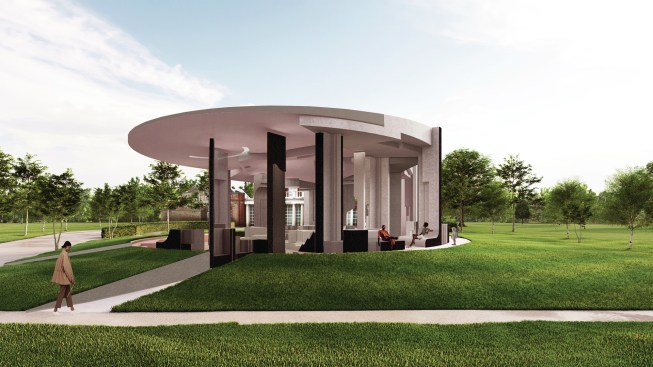
Courtesy Counterspace
Counterspace’s Serpentine Pavilion will now open in Summer 2021 instead of this year. The firm, led by Sumayya Vally, Sarah de Villiers, and Amina Kaskar, won the commission to design and construct this year’s pavilion back in February. In 2020, the designers will collaborate with the Serpentine Gallery on a series of off-site and online research projects. [Serpentine Pavilion]
Flush yer pipes: Reopening businesses and society after prolonged stay-at-home orders presents a lot of problems, and some of those might be in the water. There is a danger, with so many buildings sitting unused for weeks that we could see outbreaks of Legionnaires’ disease, a bacterial infection that can cause deadly pneumonia. To be cautious, all water systems in buildings left for more than a week should be flushed for at least a half hour, by someone wearing gloves and a mask to protect themselves. [U.S. News & World Report]
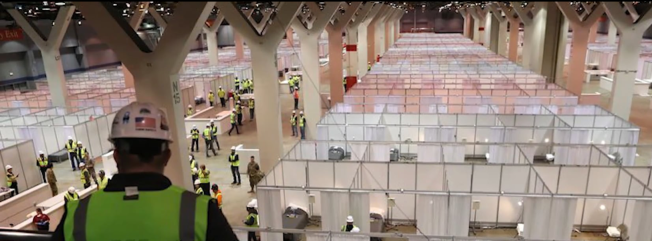
Courtesy Sloan
AECOM has converted the McCormick Place convention center in Chicago into a medical facility for COVID-19-positive patients. The first 1,000 beds are already available and are being used for patients. Sloan has provided touch-free products for the restrooms of the new field hospitals in both McCormick Place convention center and at Yale University’s Payne Whitney Gym.
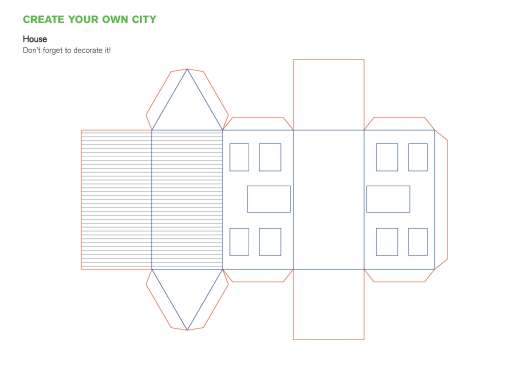
Courtesy Foster + Partners
Looking for another way to occupy your kids’ time at home? Want to get them interested in architecture? Foster + Partners has you covered with their #architectureathome series. Download the templates from their site, and get your children building everything from houses to cities. [Foster + Partners]
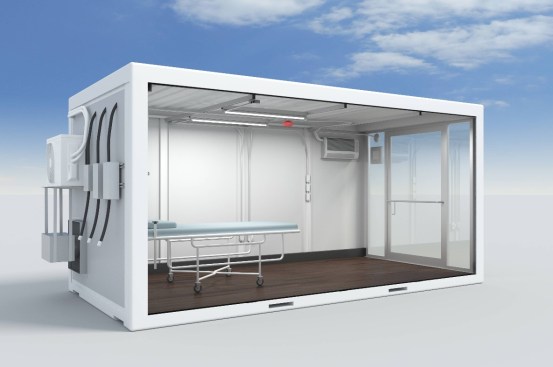
Courtesy CallisonRTKL
CallisonRTKL has partnered with facilities and infrastructure firm Patriot to transform 12- and 16-foot containers from the moving and shipping company PODS into rapid response airborne infection isolation rooms (AIIR) that can be deployed where needed to supply additional isolation rooms for highly infectious patients. [CallisonRTKL]
Building and Construction
The 30-year-mortgage rate hit its lowest number recorded (since the start of tracking in 1971) this week—3.23% [BUILDER]
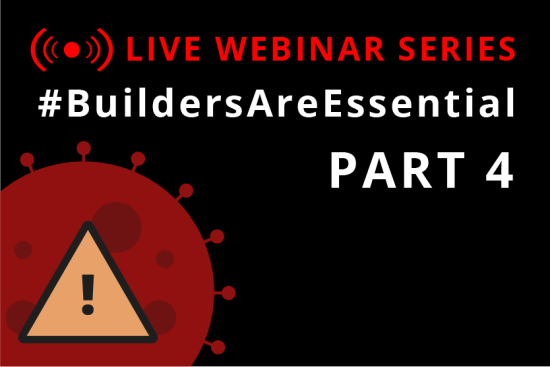
The latest episode Hanley Wood’s “#BuildersAreEssential webinar series—‘Site Safety, Mid-COVID-19’—is now available on-demand. As economies—local, regional, and national—push to reopen, reset, and reboot the urgent new normal, here’s insight and resources on technology, tactics, process remapping, practices, scheduling, logistics to protect builder health and safety.” [BUILDER]
The Portland Cement Association‘s chief economist Ed Sullivan recently gave a briefing on the “Coronavirus Impact on the Cement Industry.” (Watch it here.) Says Bill Palmer over at World of Concrete: “Over the past 20 years [Sullivan] has told us when the economy was going up and when it was going down. I’ve heard some gloomy forecasts from him before, like in 2009 and 2010, but nothing quite as disheartening as this.” [World of Concrete]
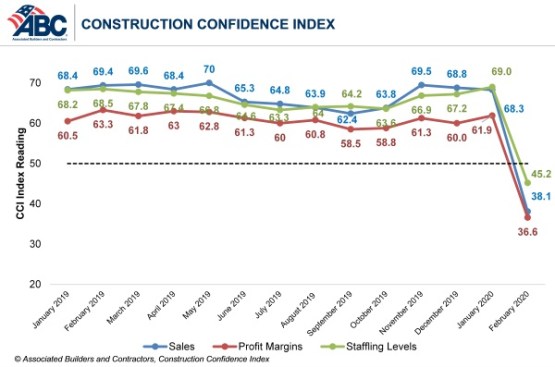
Courtesy Associated Builders and Contractors
The Associated Builders and Contractors released their monthly Construction Confidence Index last week, which showed that confidence in the U.S. construction industry dropped dramatically in February. “Readings for sales, profit margins and staffing levels expectations fell below the threshold of 50 for the first time in the history of the series, signaling expected contraction along all three dimensions. CCI is based on a survey of ABC members, which was conducted March 20-31. Fewer than 30% of survey respondents expected their sales to increase over the next six months, while less than 20% of contractors expected their profit margins to increase. More than one in five contractors expect a significant decrease in profit margins, while one in four expect a significant decline in sales volumes.” [Associated Builders and Contractors]
A survey from Clear Seas Research and BNP Media shows a view of the construction industry that is still has a dire outlook, but not as dire as it has been recently. While the worrying trend of project delays (37%) and cancellations (16%) are still up, “nearly all respondents, 92%, said activity would return to normal in 12 months or less, with 21% expecting that outcome within six months.” [ENR]
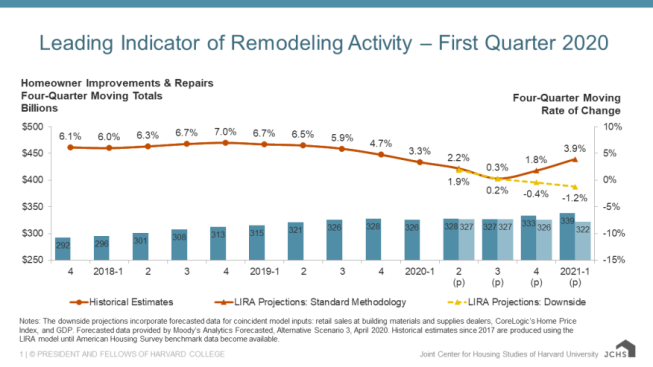
Courtesy Joint Center for Housing Studies of Harvard University
Assistant editor Vincent Salandro reports that the COVID-19 “pandemic is expected to cause owner expenditures for home renovations and repairs to decline at least through the first quarter of 2021, according to the latest Leading Indicator of Remodeling Activity (LIRA) released by the Remodeling Futures Program at the Joint Center for Housing Studies (JCHS) of Harvard University.” Salandro also reports that new “government data is in line with findings from the Associated General Contractors of America that a growing number of firms are laying off employees as a result of the coronavirus.” [REMODELING]
Senior editor Scott Sowers takes a look at apartment sizes and density across the country. [MULTIFAMILY EXECUTIVE]
Other Notable Stories We’ve Been Reading
If you‘re waiting at home, sitting on crossed fingers, hoping for antibody testing to show that way, way more people have already had the virus and that we’re way, way closer to herd immunity already, then The Atlantic‘s Sarah Zhang is here to throw some cold water on you. [The Atlantic]
Across the pond: Health care workers in the United Kingdom are raising the alarm that female staff are at a higher risk on the job. Why is that? Because, says the British Medical Association, “personal protective equipment (PPE) tends to be designed for the ‘size and shape of male bodies,’ despite the fact that 75 per cent of [National Heath Service] workers are women.” [The Independent]
Back here in America: “As the coronavirus pandemic takes a devastating toll on health care workers, death notices published in recent weeks starkly show that it is hitting Filipino Americans—who make up an outsized portion of the nation’s nursing workforce—especially hard.” That is especially true depending on the region of the country you’re talking about. For instance, in California, “nearly 20% of registered nurses are Filipinos.” [STAT]
Why are men dying at a much higher rather than women from COVID-19, at all age groups? Melbourne, Australia–based La Trobe University professor of genetics Jenny Graves wondered about that too, and examined it for the World Economic Forum. “Sex differences in the frequency, severity and treatment efficacy for many diseases were pointed out long ago. COVID-19 is part of a larger pattern in which males lose out—at every age.” [World Economic Forum]
A little good news for Lupus patients: The medicine you actually need might be getting more available and less expensive again. It looks like the demand for hydroxychloroquine by hospitals and other users is waning. There has been some increased production, but it appears that a lot of hospitals and doctors are dialing back on the controversial treatment. Says Kenneth Farber, president of Lupus Research Alliance: “One very unfortunate aspect of the whole hydroxychloroquine debate is all of the exaggeration promulgated both by the original proponents of its use for Covid-19 and by detractors of the idea of using it. Proponents exaggerated the value of the anecdotal evidence suggesting that hydroxychloroquine was a useful treatment for Covid-19 and detractors, to discourage the use of the drug, exaggerated the side-effects of hydroxychloroquine.” [STAT]
Resources
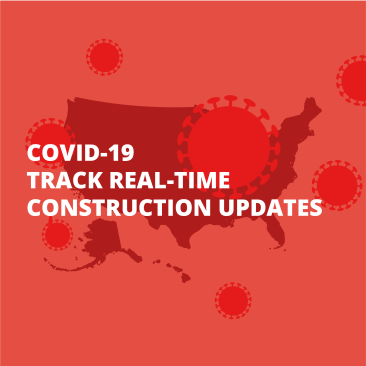
Hanley Wood publications are working together to track how state-by-state mandates are affecting the construction and building materials supplier industries. We’re updating the map and the data as they develop, so bookmark this page and check in often. [ARCHITECT]
The Institute for Health Metrics and Evaluation at the University of Washington, in Seattle, a research institute founded by the Bill and Melinda Gates Foundation, is tracking and projecting the spread and peak of COVID-19 through the United States, as well as projected numbers of deaths in each state, as measured by needed hospital capacity. [IHME]
Johns Hopkins University’s Center for Systems Science and Engineering has a worldwide real-time tracker of the spread of the virus and its impact. [CSSE]
On the Way Out …
That’s it for this week. Stay safe out there everyone, keep washing your hands and wearing your masks, and we’ll see you here again next week.
This article has been updated to reflect facilities and infrastructure firm Patriot’s involvement in developing rapid response airborne infection isolation rooms with CallisonRTKL.
